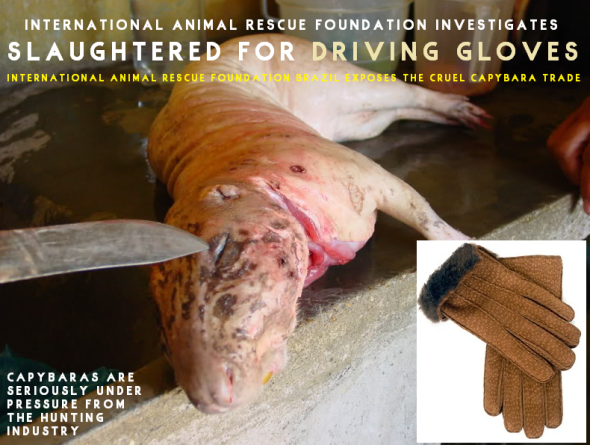
CRUEL CAPYBARA LEATHER AND MEAT TRADE
Introduction:
Many people reading this article may never have seen or heard of the Capybara, however the species is still just extant of which both the lesser Capybara and greater Capybara are facing extinction due to over-hunting, poaching and unfortunately the cruel, barbaric leather and fashion trade. (Image: Capybara killed for meat and skin)
Endemic to South America the Capybara that is classed as a rodent is the largest rodent of its kind on the face of the planet. Furthermore due to its craved after soft hide the Argentinian and Peruvian government back in the 1960’s regulated the trade of Capybara from which the worlds largest rodent is now nothing more than a fashion accessory.
International Animal Rescue Foundation Brazil have been undertaking investigations on Argentinian Capybara farms where they have located some of the most unpleasant abusive regimes. Filthy and repulsive grounds that the worlds largest rodent is being farmed on, and slaughter men secretly filmed by the team playing football with one of the young from which it later died an agonizing death. Please be aware that the team could not intervene as that would have compromised the entire investigation thus leading to them being arrested for trespassing, and subsequently removed from the country back to Brazil.
The videos are so traumatic and emotionally distressing we’ve passed them onto the Police and are now making some of our preliminary findings in brief aware to the general public. Furthermore we please advise all members of the public to please boycott all ‘Argentinian Capybara leather products’. These products will have a stamp on the inside or outside that typically will depict the traditional stamp with ‘Argentinian made and farmed Capybara leather’ imprinted on the product.
Preliminary Findings:
Capybara-Carpincho Leather Trade.
International Animal Rescue Foundation Brazil (IARFB) have in the past three months embarked on a mission to promote awareness of our South American native Capybara, and to bring the current illegal black market leather industry that is pushing the species into extinction to a halt. This is not going to be easy though, and we need your help. Many people often associate leather with cows, smaller ungulates, snakes, crocodiles and other soft/hard skinned animals of which their skins are collected as a bi-product throughout the agricultural and farming trade worldwide.
Fortunately while many of the animals listed above will probably never go extinct within the regulated farming industry that supplies leather products internationally and locally. The Capybara are seriously threatened by the ongoing leather trade, that is sought after throughout South America, primarily throughout Argentina. Capybara’s are farmed legally for their hides, and hunted legally and illegally for their exquisite leather hide that’s currently being shipped overseas to large well known international renowned clothing, and fashion industries within America, Canada, United Kingdom, Asia and Europe.
Many people are completely oblivious to the trade, or even know that the worlds largest semi-aquatic rodent is nearing extinction due to trade, demand and fashion. Today we lift the lid on this horrifying trade and those that are importing Capybara leather. from 1976 to 1979 almost 80,000 skins were exported from Argentina. In the past three months we have obtained some of the most sickening, barbaric and damn right bloody cruel farming practices that we cannot post onto our Facebook page. We will be posting these shocking exposures soon via our environmental and animal welfare investigations site speakupforthevoiceless.org
Many leather companies that produce Capybara leather will try and tell you that its currently illegal to kill the species in the wild. In reality there is no such law that we are aware of, nor has it ever been listed on the International Union for the Conservation of Nature, which we are members of. However at times if one is caught poaching enforcement teams will seek an arrest and conviction, this is rare though.
Within the leather industry the Capybara is commonly known as the ‘Carpincho’ which means water pig and is the largest rodent in the world. One only has to Goggle search “Carpincho leather” to see just how large this trade is. Furthermore black market trade was uncovered by our major investigations unit of which not a single piece of Carpincho leather was stamped and was being sold at a knock down price, which in turn will see more and more people move to the illegal traders rather than the regulated trade. This in turn will see our ‘wild specimens completely obliterated, equaling extinction’.
While the species is not as yet considered endangered, the sheer fact that most Argentinians own at least some form of Capybara leather, and crave it yearly (especially for Christmas gifts). Its quite likely the species is going to plundered into extinction very soon. Argentaina is one of few countries that we know of that “regulates the trade of Capybara leather”, meaning the species are removed from the wild cruelly, bred then killed to provide anything from gloves, slippers, wallets, coats, belts Etc. One of the most sought after Capybara leather products is that of driving gloves that are manufactured mainly within Argentina then sold by companies worldwide. Prices can range from anything to $50.00 to $400 a pair. The soft leather product is craved after due to its ability to make driving easy via allowing the steering wheel of the car to glide easily between the gloves and drivers hands.
Argentina makes no effort to hide their filthy trade either of which they insist each product must be stamped as farm raised. Its alleged that Argentina is the only manufacturing exporter in the world of Capybara products. Unfortunately International Animal Rescue Foundation Brazil has located a sickening black market trade throughout South America spanning into Viet Nam, China, Laos, Cambodia and Malaysia. Concerning; when we (IARFAB) visited Northern Europe we located countless high street shops that are selling Capybara products too that seem oblivious to the fact that the illegal wildlife trade decreases profit in the “regulated trade” which in turn is placing the species on the verge of nearing extinction within their endemic wild. Some of the companies located online can be seen below.
1. Italian and American Leather Gloves offers you the ‘genuine hand made Capybara product made my Fratelli Orsini’: http://www.leatherglovesonline.com/np/MensGloves-ByStyle-Driving-ca3198-mens-carpincho-driving-gloves.htm#page=details
2. Hestra Gloves offers a wide range of Capybara leather products although their main interest in this leather are driving gloves. https://hestragloves.com/dress-gloves/en-us/article/leather-guide/
3. Lundorf Christiano that’s supported by Amazon offers yet another range of “genuine Capybara leather gloves”.
http://www.amazon.com/Lundorf-Christiano-Carpincho-Leather-Gloves/dp/B00GMR2VW0
4. Alibaba that we’ve exposed countless times for allowing traders to peddle rhino horn parts and ivory, are also promoting the sales of Capybara leather.
http://www.alibaba.com/product-detail/Carpincho-Capybara-Gloves_11783877.html?spm=a2700.7724857.29.46.TpkHqB
As explained above many companies within Argentina will try and palm people off that are purchasing Capybara products that hunting is ‘strictly illegal’ and the animals are protected under Argentinian law. That’s not necessarily true and, we’ve located countless South American hunting outfitters that hunters from around the globe visit to hunt legally the Capybara species. See image below.

Image: Capybara hunting is legal within Argentina. American hunter with threatened species
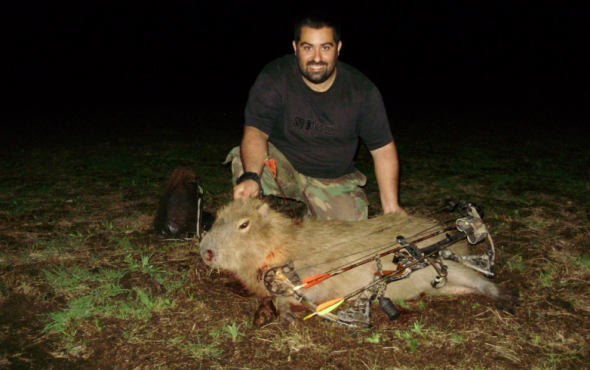
Image: Hunter with threatened Capybara

Image: Hunter with threatened Capybara
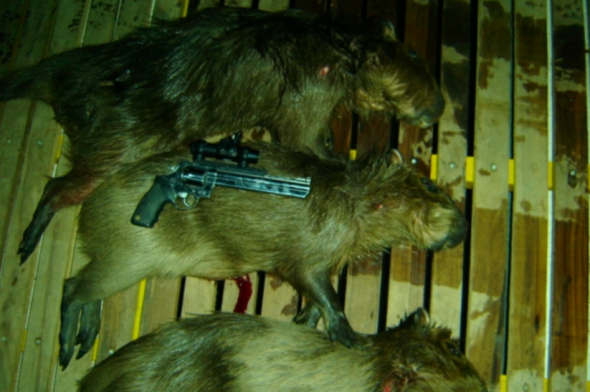
Image: The sickening images of dead Capybara slaughtered with a handgun
The International Union for the Conservation of Nature has stated that the greater Capybara is listed as (least concern) and the lesser Capybara is (data deficient). So whats the big deal then? The IUCN has listed the lesser Capybara as data deficient as they currently do not know how many are remaining within the wild. So while hunting, poaching and the clothing industry takes its share. Research could prove within a few years that the lesser Capybara is in fact seriously threatened.
Meanwhile the greater Capybara that is listed as explained above as (least concern) is seriously threatened by the pressures of hunting. The IUCN quotes:
“This species is severely threatened by hunting; some local populations have been extirpated (Eisenberg and Redford 1999). Capybara leather is valued in South America and from 1976 to 1979 almost 80,000 skins were exported from Argentina (Eisenberg and Redford 1999). There is a large internal market for the skins”
Extinction of the Capybara would have a detrimental affect to the ecosystem:
So as one can see, unless action is taken sooner rather than later to remove one or most of these threats its very likely that we’re going to lose the worlds largest semi-aquatic rodent due to one of the above destructive actions. International Animal Rescue Foundation Brazil that undertakes animal and environmental investigations throughout South America; Stated “should we lose both the lesser and greater Capybara within the ‘wild’. The knock on effect this would have to our already threatened and fragmented ecosystem would be large”.
Capybaras’ are herbivores that consume mainly grasses, aquatic plants, fruits and bark. Should both the larger and greater Capybara go extinct, plant-life would be affected. Herbivores consume plants that contain seeds, these seeds pass through the digestive system of the animals as they are moving around the forest floor, which are then deposited via feces, thus equaling spread of plant-life. One less herbivore means less movement and spreading of plants that are required for other animals to consume, and medicinal plants that humans require for natural medicines.
The same applies to fruit too, not forgetting aquatic plants that need to spread throughout local rivers and streams that fish and small wildlife rely on to conceal themselves within from predators. Alien plants that the Capybara feeds on would also take over the forest floor thus pushing native non-alien plants into extinction. Extinction of both genera of the Capybara would therefore be catastrophic.
International Animal Rescue Foundation Brazil are currently working to increase awareness of the Capybara and will be undertaking demonstrations outside of trading stores that trade in Capybara leather products. You can help International Animal Rescue Foundation Brazil with its current investigations by sending any small or large donation. Simply click here https://www.paypal.com/uk/webapps/mpp/send-money-online add our email that is here: info@international-animalrescue-foundation.org.uk then your kind donation, then simply hit send.
The Capyabara pictured below is not protected as many have been led to believe. Furthermore if the clothing and fashion industry as well as the hunting industry is not regulated accordingly we’ll lose the entire species within ten years. The (IARFB) are working on fact sheets for local schools, universities and will be running classes to increase awareness and education about the species of which your help is required. For more information please email the team above.
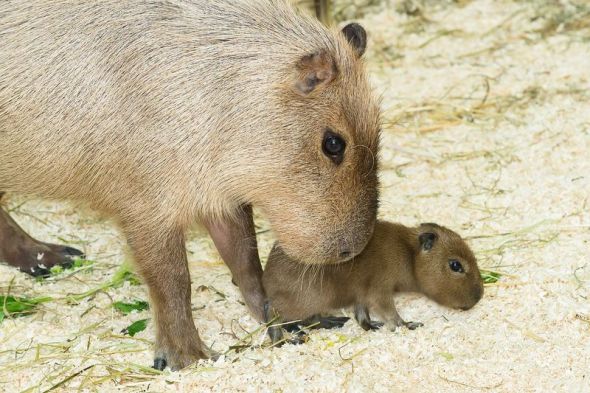 Image: Capybara mother and young
Image: Capybara mother and young
Dr Jose C. Depre.
Environmental and Botanical Scientist.
Director/ CEO
November 7, 2015 | Categories: You must be the change you want to see in the world | Tags: Animals, Argentina, bush meat, Capybara, Dr Jose Depre, Extinction, greater capybara, International Animal Rescue Foundation Brazil, largest rodent on earth, leather, leather gloves, leather shoes, leather wallets, lesser capybara, Peru, rodent, south america capybara, Wildlife | Leave a comment
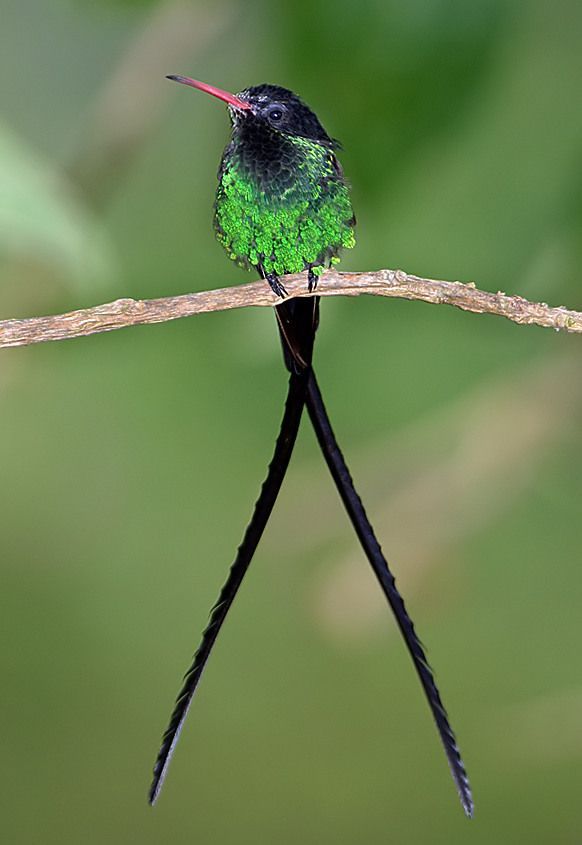
Endangered Species Monday: Hylonympha macrocerca
This Monday’s Endangered Species Post (ESP) watch I take a rare glimpse into the life of Hylonympha macrocerca, commonly known as the Scissor Tailed Hummingbird. Identified in 1873 by Dr John Gould FRS September 1804 – 3 February 1881) whom was an English ornithologist and bird artist. He published a number of monographs on birds, illustrated by plates that he produced with the assistance of his wife, Elizabeth Gould, and several other artists including Edward Lear, Henry Constantine Richter, Joseph Wolf and William Matthew Hart. He has been considered the father of bird study in Australia and the Gould League in Australia is named after him. His identification of the birds now nicknamed “Darwin’s finches” played a role in the inception of Darwin’s theory of evolution by natural selection. (Image: Scissor Tailed Hummingbird)
Listed as (endangered) this remarkable specimen was listed as threatened back in 1988. Since this time little conservation efforts have been seen to improve the species overall status within the wild of which extinction is incredibly likely. From 1994 to 1996 the species was listed as critically endangered. From the start of the Millennium conservation efforts did improve the wild status of the hummingbird to (vulnerable), unfortunately from 2008 to date the species has been re-listed as endangered again. From my own evaluations of the birds current threats and shrinking habitat, extinction will occur within the next five to ten years, unless conservation efforts improve, funding increases and dangers disperse soon.
Endemic to Venezuela and Bolivia evidence has shown that overall population sizes are decreasing very rapidly. The population trend when last evaluated back in 2012, showed around 10,000 to 19,900 ‘individuals’ within the wild. This equates to exactly 6,000 to 13,000 ‘mature individuals’ remaining, which is rounded to 6,000 to 15,000 ‘birds in total’. The Scissor Tailed Hummingbird specie inhabits lower and upper montane humid forest, where it has been recorded at 800-1,200 m on Cerro Humo, and 530-920 m further east.
In primary forest, the specie feeds mainly at bromeliad flowers and on their insect inhabitants, whereas in secondary forest, feeding is associated with the shrubs Heliconia aurea and Costus sp. Although it is regularly seen feeding on Heliconia in open areas it may nevertheless be dependent on the availability of pristine forest nearby. It also hawks insects from exposed perches. There may be seasonal movements.
Major Threats
Listed on Cites Appendix II (Convention on International Trade of Endangered Species wild flora and fauna), increases in cash-crop agriculture, especially the cultivation of “ocumo blanco” (Xanthosoma sagittifolium) and “ocumo chino” (Colocasia esculenta), since the mid- to late 1980s have resulted in some uncontrolled burning and forest degradation. Cerros Humo and Patao have been worst affected, with the east of the peninsula fairly undisturbed.
Since it is an understorey inhabitant, removal of understorey vegetation for coffee and cacao cultivation is likely to lead to reduced population density. It is considered nationally Endangered in Venezuela, and has been recognized as a “high priority” species, amongst the top dozen priorities for bird conservation in Venezuela.
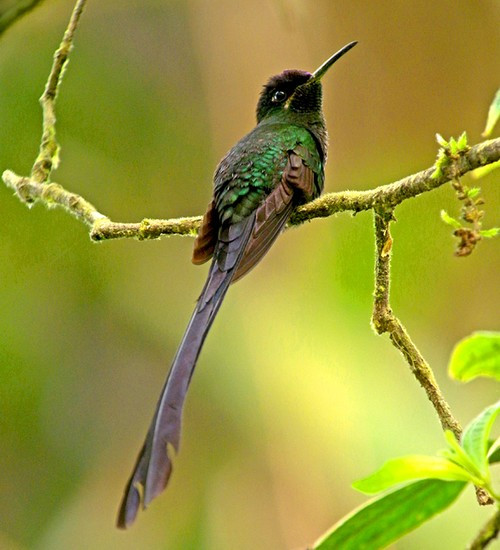
Image: Scissor Tailed Hummingbird.
Occasionally the species is misidentified as the Red-billed streamertail which is also commonly known as the scissor-tail or scissors tail hummingbird. However its fairly easy to distinguish between the two when viewing online or within books. This particular species (in question) is not native to Jamaica, and one can quite easily differentiate between the two. The Scissor Tailed Hummingbird has obviously acquired its name due to its unique scissor tailed rump feathers, whereas the Jamaican Red-billed streamertail doesn’t host the same features but more as explained - streamer like rump feathers.
Sadly as explained due to increasing threats we will lose this bird unless conservation efforts improve dramatically and dangers subside. However this is unlikely to occur. The Scissor Tailed Hummingbird will be yet another species of bird added soon to the extinction list of amazing birds, that we humans have destroyed. The video below depicts a female Scissor Tailed Hummingbird within the Venezuela wild.
Thank you for reading.
Dr Jose C. Depre.
Environmental and Botanical Scientist.
October 18, 2015 | Categories: You must be the change you want to see in the world | Tags: Birds, Bolivia, Dr Jose C. Depre, Extinction, Hummingbird, International Animal Rescue Foundation Brazil, Red Billed Streamertail, Scissor Tailed Hummingbird, South America, Venezuela, Wildlife | Leave a comment
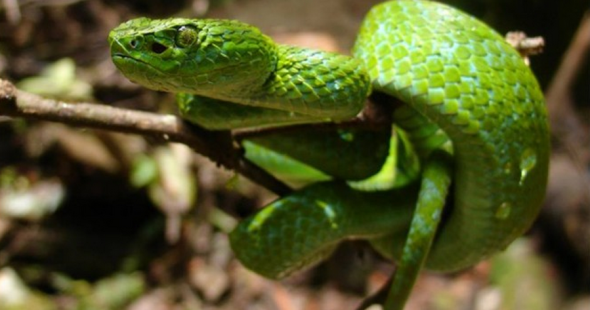
Endangered Species Friday: Bothriechis marchi
This Fridays endangered species watch post (ESP) I focus ones attention on reptilians which I rarely do speak or document about. Awareness surrounding this stunning Pit Viper needs creating rather quickly, before populations go extinct. (Image credits: Dr. Silviu Petrovan B. marchi)
Endemic to Honduras (mainland) and scientifically identified as Bothriechis marchi the specie is listed as [endangered] of which populations are declining quite extensively throughout its entire range. B. marchi was identified by two environmental scientists that I’ve listed below;
1. Dr Thomas Barbour (August 19, 1884 – January 8, 1946) whom was an American herpetologist. From 1927 until 1946, he was director of the Museum of Comparative Zoology founded in 1859 by Louis Agassiz at Harvard University in Cambridge, Massachusetts. Dr Barbour identified B. marchi back in 1929.
2. Dr Arthur Loveridge (1891-1980) whom was a British biologist and herpetologist who wrote about animals in East Africa, particularly Tanzania, and New Guinea. He gave scientific names to several gecko species in the region. Dr Loveridge identified with Dr Barbour, B. marchi back in 1929.
The species was known to be quite common throughout its entire range from the mid 1980’s right-through to the early millennium. Since last observations took place around 2000 there has been few sightings of the species due to increasing threats on the mainland.
Commonly known to the locals as the Honduran Palm Pit Viper or March’s Palm Pit Viper the species is known to occur within Northern Honduras of which extends into Eastern Guatemala. Range has been reported to be some 500m to 1,500 (m) in elevation however the species is considered rare at anything below 900 (m). There have been few reports of specimens recorded below the 900 (m) elevation in Nicaragua by Villa 1984. Furthermore a few individual specimens have also been recorded at sea level.
While there are an assortment of threats that indeed pose a risk to the species the main primary reason B. marchi qualifies for the endangered listing is due to the very small locations that the species is known to inhabit. From previews records we know the species now only exists at some five to six locations of which any-form of habitat fragmentation or destruction could/would lead to species into extinction.
Even throughout the species very small range habitat loss, collapse of prey populations, and extraction for the pet trade still occurs despite the March’s Palm Pit Viper listed as endangered and, protected. One can normally locate the species next to running streams, water courses or within closed intact rain forest. To date there are no sub-species known and one must also point out the March’s Palm Pit Viper is indeed (venomous). Diet normally consists of frogs, newts, and rodents.
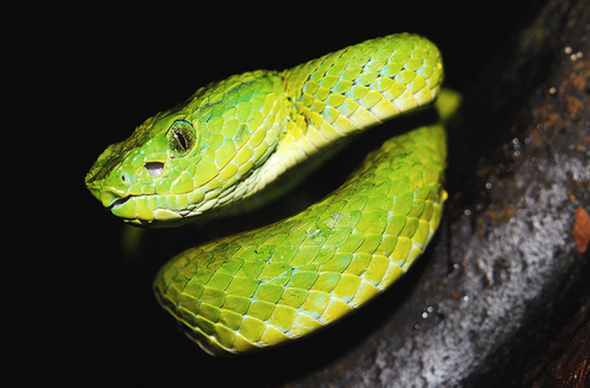
Image: Honduran Palm Pit Viper. (Photographer unknown).
Listed on Cites Appendix II there remains very little conservation projects in place to actually preserve the species despite Cites stating pet trade must be [regulated]. If anything there should be no pet trade and the Government of Honduras now needs to implement tough policies and regulations to ensure species survival for future generations to come. Cites in my own opinion needs to pull their finger out and restore a little faith back into the public domain as clearly very little if any monetary income is being made from the pet trade that is helping sustain conservation projects within the species range.
Threats
One of my own major concerns here on the mainland and Honduras islands is deforestation. Many of you or may not be aware, some months back we ran a conservation project on the Honduras White Bat of which deforestation was primarily to blame for the bats decreasing populations. Unfortunately the same threat also applies to the March’s Palm Pit Viper (which I find very worrying).
Timber extraction and habitat destruction is increasing on the mainland at an alarming rate placing the March’s Palm Pit Viper in danger furthermore. This species is also threatened by extraction for the pet trade. For example the Honduras authorities have issued permits for exportation of hundreds of individuals annually. Furthermore, the crash in amphibian populations threatens this species.
I must also point out that while timber extraction is placing increasing pressure on many species of fauna and flora illegal and unregulated logging remains an ever-increasing threat to sustainable development programs. Who’s to blame for this illegal logging crisis? United States and Europe have been exposed in many environmental investigation projects, timer extraction projects also increase poverty, fuel corruption not forgetting devastating communities throughout the mainland and islands. Although some actions have been taken to decrease illegal logging threats - they still very much remain and as such will push the Honduran Palm Pit Viper into extinction should measures not be implemented to protect wildlife immediately..
Please note that while there has been some-speculation there may well be a new sub-species, Bothriechis guifarroi is not related to B marchi, although near threatened the species is still pretty remarkable.
Sadly we don’t have a video for you to view the Honduran Palm Pit Viper however I’ve included a Viper video that you may enjoy.
- Have a nice day.
Thank you for reading.
Chief Environmental Officer. (Executive Director)
Dr Jose C. Depre
International Animal Rescue Foundation Africa.
info@international-animalrescue-foundation.org.uk
July 31, 2015 | Categories: You must be the change you want to see in the world | Tags: Bothriechis guifarroi, Bothriechis marchi, Cites, Cites Appendix II, deforestation, Dr Thomas Barbour, Dr. Silviu Petrovan, Eastern Guatemala, Endangered, Extinction, Extraction, Friday, Fridays Animal, habitat destruction, Honduran, Honduras, Honduras White Bat, IARF, International Animal Rescue Foundation Brazil, Jose Depre, March's Palm Pit Viper, Nicaragua, Northern Honduras, Palm Pit Viper, Pet trade, Reptile, Snake, sustainable development programs, Timber, Viper. Honduran Palm Pit Viper | Leave a comment
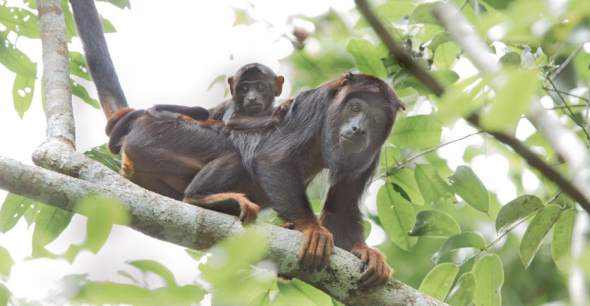
Endangered Species Monday: Alouatta belzebul
This Monday’s endangered species article from the (Endangered Species Watch Post) focuses on the Red Handed Howler Monkey of which is listing near to endangerment. (Image Red Handed Howler Monkey)
Generically identified as Alouatta belzebul back in 1766 by Professor Carl von Linnaeus (1707 – 10 January 1778), also known after his ennoblement as Carl von Linné was a Swedish botanist, physician, and zoologist, who laid the foundations for the modern biological naming scheme of binomial nomenclature.
Listed as vulnerable the species is endemic to Brazil (Alagoas, Maranhão, Pará, Paraíba, Pernambuco, Rio Grande do Norte, Sergipe and Tocantins). Populations are currently on the decline of which its very likely the species will be re-categorized as endangered within the next five years, if not sooner.
A. belzebul is said to be extremely common in some areas such as Marajó however is noted as rare within the Atlantic Forest portion of the range known as; Rio Grande do Norte, Alagoas, Paraíba and Pernambuco. Last survey census’s reported the species to be inhabiting at least ten isolated locations of which two hundred individuals remain in each plot.
International Animal Rescue Foundation Brazil have for the past three years been conducting surveys within the area will be submitted to the (IUCN). Furthermore the Environmental Protection Unit now re-based in Londrina are working with local communities, hunters and farmers within the A. belzebul range to preserve commonly known species of monkey, birds, amphibians and flora within the region.
IARFB are also currently conducting investigations to locate where sugar cane is being exported too and used within from the A. belzebul’s region. Its believed that America, Mexico, South America, and Europe are purchasing large sugarcane exports from the region. Tesco, J.S Sainsbury’s, Cooperative Food Group, Asda, Walmart, Woolworths and Spar have all been noted on suppliers exports from the regions. Aldi, Lidl, Quick-Save, Budgens have been ruled out. We are least impressed though with J.S Sainsbury’s name written on export documents of sugar cane from the region.
Within the ten isolated locations six populations are known to reside in Paraiba, two in Rio Grande de Norte, one in Pernambuco, and one in Alagoas. The largest population in the Atlantic Forest is in Pacatuba in Paraiba with about 80 animals. There have been five registered local extirpations from forest fragments in the last 50 years.
Little known conservation actions are under way within their endemic region and as explained populations are decreasing and nearing endangerment. A. belzebul is listed within the family of Atelidae which is one of the very first five of new recognized ‘new world monkeys’. Its quite likely that new sub-species of the Red Handed Howler Monkey may be located as well as newer species of ‘new world monkeys’ too within the coming years. Only five years ago did scientists locate over 100,000 new species within the Yasuni National Park, Ecuador so in reality anything is possible.
The Atelidae family host howler, spider, woolly and woolly spider monkeys (the latter being the largest of the New World monkeys). They are found throughout the forested regions of Central and South America, from Mexico to northern Argentina.
When the species is not foraging on the ground floor they can normally be found resting in the canopies of trees at a height of some sixty feet. Social groups normally consist of seven to twenty members that will host mature males, females juveniles and infants. Males normally take lead of the pack or (troop).
These large and slow-moving monkeys are the only folivores of the New World monkeys. Howlers eat mainly top canopy leaves, together with fruit, buds, flowers, and nuts. They need to be careful not to eat too many leaves of certain species in one sitting, as some contain toxins that can poison them. Howler monkeys are also known to occasionally raid birds’ nests and chicken coops and consume the eggs.
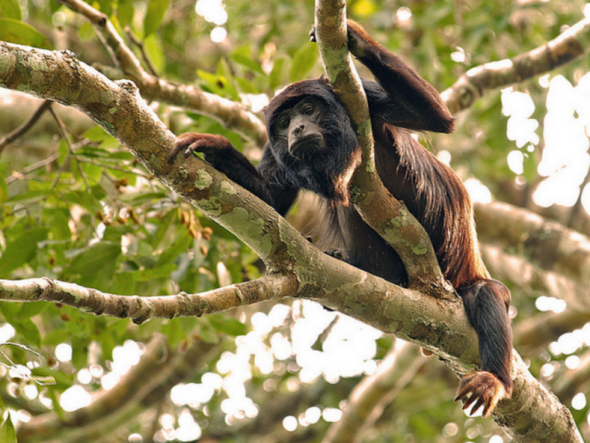
Image: Adult Red Handed Howler Monkey.
Howlers are the only New World primates which regularly include mature leaves in their diet, although softer, less fibrous, young leaves are preferred when they are available. Their folivory and ability to eat mature leaves is undoubtedly one of the keys to their wide distribution and the wide variety of vegetation types they inhabit.
Mature fruit is the other important food item, especially wild figs (Ficus) in many regions, but they also eat leaf petioles, buds, flowers (sometimes seasonally very important), seeds, moss, stems and twigs, and termitaria. The diet of two A. belzebul groups in the Caxiuanã National Forest was studied by Souza et al. (2002). They were largely folivorous but would switch to fruits whenever available, especially during the wet season.
Size:
Adult male weight 7.27 kg (n=27),
Adult female weight 5.52 kg (n=26)
Adult male weight 6.5-8.0 kg (mean 7.3 kg, n=27),
Adult female weight 4.85-6.2 kg (mean 5.5 kg, n=26) .
Threats
Listed on Cites Appendix II there are few threats associated with the species. Nevertheless they still remain and if left unchecked can rapidly increase placing the new world monkey in danger of extinction.
In the Amazon, the species is widespread, although they are hunted. The Amazon populations have suffered severely from forest loss throughout their range in southern Pará over the last decade. In the Atlantic Forest population, the major threat is the fragility of the remaining small forest patches to stochastic and demographic affects (habitat loss and fragmentation has been mainly due to sugar-cane plantations).
Please share and make aware the Red Handed Howler Monkey’s plight. Tip: Check sugar products from local shops and hypermarkets to ensure your not aiding the destruction of their natural habitat via your sugar purchase. Check your local candy and other shopping supplies. If necessary contact companies politely asking where they are obtaining the sugar products from. Never give up.
Thank you for reading.
Dr Jose C. Depre.
Environmental and Botanical Scientist.
Chief Executive Officer
July 20, 2015 | Categories: You must be the change you want to see in the world | Tags: Alagoas, Alouatta belzebul, Amazon Forest, Animals, ASDA, Brazil, Carl von Linne, Caxiuanã National Forest, CoOp, Cooperative Food Group, Cooperative Society, Dr Jose Depre, Endangered, Endangered species, folivores, Howler, Howler monkeys, I.A.R.F, IARF, International Animal Rescue Foundation Brazil, IUCN, J.S Sainsbury's, Jose Depre, Maranhao, Monday, Monday Endangered Species Post, Monday's Animals, New World Monkeys, Para, Paraiba, Pernambuco, Professor Carl von Linnaeus, Red Handed Howler, Red Handed Howler Monkey, Rio Grande do Norte, Sergipe, South America, Spar, Species. Alouatta belzebul, Tesco, Tocantins, Vulnerable, Walmart, Weekday, Woolworths, Yasuni National Park | 1 Comment















